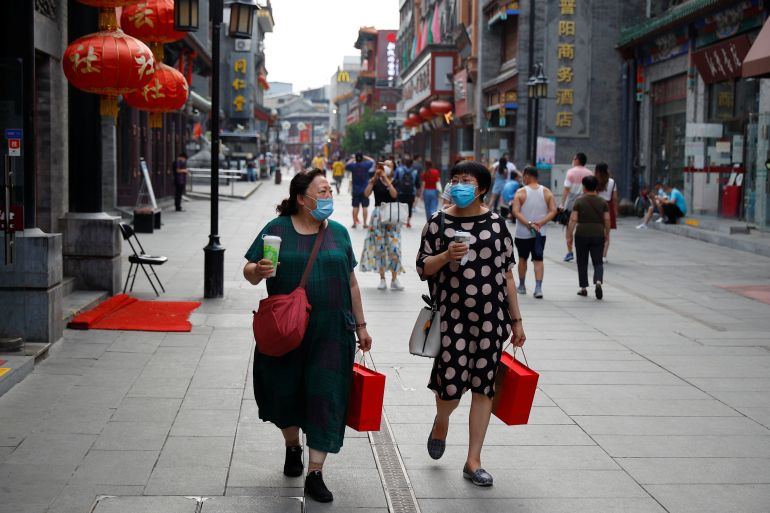China’s consumers likely gave economy a boost in third quarter
Economic growth is expected to have accelerated to 5.2 percent in the July-September period from 3.2 percent in the previous three months, economists say.

China’s economic recovery likely stepped up in the third quarter as consumers returned to shopping malls and large trading partners reopened for business, shaking off the record slump seen earlier this year.
The world’s second-largest economy is expected to have grown by 5.2 percent in July-September from a year earlier, faster than the second quarter’s 3.2 percent expansion, according to a poll of economists by the Reuters news agency.
Keep reading
list of 4 itemsMexico’s teachers seek relief from pandemic-era spike in school robberies
‘A bad chapter’: Tracing the origins of Ecuador’s rise in gang violence
Why is the US economy so resilient?
A similar survey by the Bloomberg news agency predicts a 5.3 percent growth rate.
The International Monetary Fund has forecast an expansion of 1.9 percent for China for the full year, the only key economy expected to report growth in 2020.
Policymakers globally are pinning their hopes on a robust recovery in China to help restart demand as economies struggle with heavy lockdowns and a second wave of coronavirus infections.
![China GDP chart [Bloomberg]](/wp-content/uploads/2020/10/365276251.jpg?w=770&resize=770%2C503)
“China has become the first major economy to return to its pre-virus growth path, thanks to its rapid containment of COVID-19 and effective stimulus response,” said analysts from Capital Economics. However, they warned a renewed slowdown is likely from late 2021 as stimulus measures fade.
China’s retail spending has lagged the comeback in factory activity as heavy job losses and persistent worries about infection kept consumers at home, even as restrictions lifted.
However, that is expected to have changed in the third quarter.
In September, auto sales marked a sixth straight month of gains with a solid 12.8 percent growth. Ford Motor Co’s China vehicle sales jumped 25 percent in the September quarter from a year earlier.
A rebound in domestic passenger flights in September indicated that sector was approaching a full recovery.
But the rebound in spending appears to have been uneven, relying on richer Chinese spending on luxury goods and holidays, with many poorer people still hit hard by job and income losses due to the pandemic.
![China consumer spending chart [Bloomberg]](/wp-content/uploads/2020/10/365303604.jpg?w=770&resize=770%2C456)
The coronavirus pandemic, which caused China’s first contraction in the first quarter since at least 1992, is now largely under control, although there has been a small resurgence of cases in the eastern province of Shandong.
Year-on-year forecasts by 51 analysts polled by Reuters ranged from 2.5 percent to 7.2 percent for the third quarter.
On a quarterly basis, gross domestic product (GDP) is expected to have grown by 3.2 percent in July-September compared with a rise of 11.5 percent in the previous quarter.
Support measures
The government has rolled out a raft of measures, including more fiscal spending, tax relief and cuts in lending rates and banks’ reserve requirements to revive the virus-hit economy and support employment.
China releases third-quarter gross domestic product data on Monday at 02:00 GMT, along with September factory output, retail sales and fixed-asset investment.
Analysts polled by Reuters expect industrial output to have grown by 5.8 percent in September from a year earlier, quickening from a 5.6 percent rise in August, while retail sales were seen rising 1.8 percent, versus a 0.5 percent rise in August.
While the central bank stepped up policy support earlier this year after widespread travel restrictions choked economic activity, it has more recently held off on further easing.
“Because of the ongoing growth recovery but still strong headwinds, we expect Beijing to maintain its ‘wait-and-see’ policy approach through the remainder of this year,” said analysts at Nomura in a note this week.